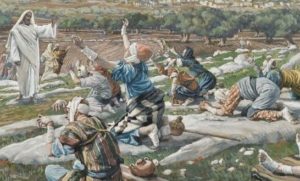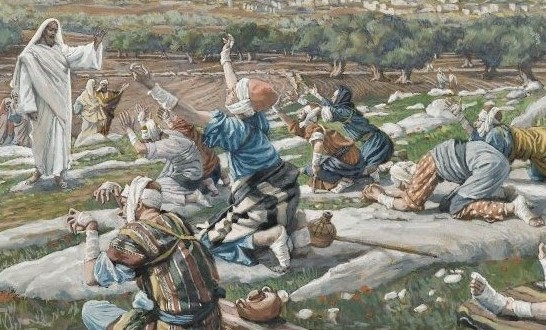
The Gospel for Wednesday of the 32nd Week of the Year teaches that the Mass is the perfect offering of thanks to the Father. It does so in a remarkable and almost hidden way, but it is right there for us to see if we have eyes to see it.
The Gospel telling the story of the ten lepers contains all the essential elements of Holy Mass and thus it reminds us once that it is the Mass that is the perfect thanksgiving, the perfect Eucharist.
As Jesus continued his journey to Jerusalem, he traveled through Samaria and Galilee. As he was entering a village, ten lepers met him. They stood at a distance from him and raised their voice, saying, “Jesus, Master, have pity on us!” And when he saw them, he said, “Go show yourselves to the priests.” As they were going they were cleansed. And one of them, realizing he had been healed, returned, glorifying God in a loud voice; and he fell at the feet of Jesus and thanked him. He was a Samaritan. Jesus said in reply, “Ten were cleansed, were they not? Where are the other nine? Has none but this foreigner returned to give thanks to God?” Then he said to him, “Stand up and go; your faith has saved you” (Luke 17:11-19).
Let’s look and see how it is a Mass:
Gathering – Notice first that there is a gathering, of ten lepers, and they meet Jesus as he enters the village. We do this in every Mass: we gather, and the Lord draws near. In the person of the priest, who is the sacrament, who is the sign of His presence, Jesus walks the aisle of our church just as He walked those ancient roads.
Kyrie – Next, the lepers cry out for mercy just as we do at every Mass: Lord, have mercy! Jesus, Master, have pity on us!
Liturgy of the Word – Jesus then quotes Scripture and applies it to their life just as He does for us at every Mass. In saying, “Go show yourselves to the priests,” Jesus is referencing Leviticus 14, which gives detailed instructions as to how priests were to diagnose leprosy and how they were to determine that it had been cured. This is what is done at every Mass: God’s Word is proclaimed, and then the Lord Jesus, speaking through the priest or deacon, applies the texts to our lives.
Liturgy of the Eucharist – Next, one of the lepers fell at the feet of Jesus and thanked him. This is what we do during the Eucharistic prayer: we kneel and thank Jesus, and with Jesus we give thanks to the Father. The word Eucharist comes from Greek and means “to give thanks.” Here, the perfect thanks is rendered to the Father. Those who claim that they can stay home and give adequate thanks to God there should be rebuked as prideful. Only Jesus can give perfect thanks to the Father, and we can only give adequate thanks to Jesus by following His command to “Do this in memory of me.” We must be at Mass.
Ite Missa est – Finally, Jesus sends the leper on his way, saying, Stand up and go; your faith has saved you. We, too, are sent forth by Jesus at the end of every Mass, when He speaks through the priest or deacon: “Go forth, the Mass is ended” or “The Mass is ended. Go in peace.”
So, there it is. In this Gospel, which clearly instructs us to give thanks to God, is the very structure of the Mass. If you want to give proper thanks to God, and you are at Mass today, you’re in the right place. Only at Mass is perfect and proper thanks given to God.
It was all prefigured in this psalm: What return shall I make to the Lord for all the good he has done for me? The cup of salvation I will take up and call on the name of the Lord (Psalm 116:12). At every Mass, the very cup of salvation—the chalice containing Christ’s blood—is held up. It is the perfect sacrifice of thanks. It is the prescribed sacrifice of praise, the proper sacrifice of praise.
https://youtu.be/RZ1IpqlOWpE


I love how you break open Scripture!!! How many more of these hidden Masses are there? I can only think of Emmaus.
I like the idea that the lepers were sent to show themselves to the priests as part of the practice of following traditions and community worship, ie, the Mass. The action of returning individually and giving personal thanks, one on one with Jesus, is also important, ie, a time of Adoration. Both are significant in living our faith.